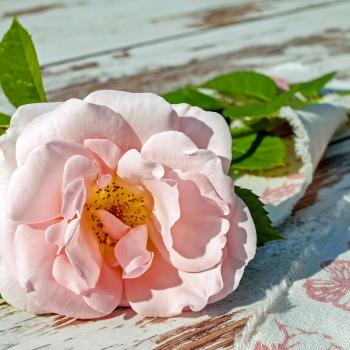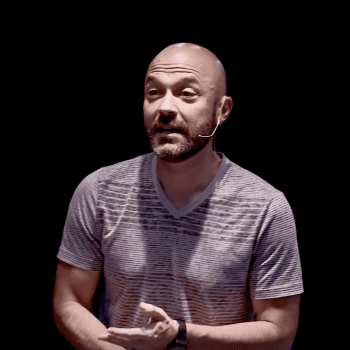 A guest post by Danielle of From Two to One.
A guest post by Danielle of From Two to One.
I Wore A Purity Ring, But No One Got It
For as perverted as my introduction to purity culture and rings was during my teenage years, I think fondly of my purity ring and its continuing role as my husband’s wedding ring. But as a feminist and a Christian, I straddle two conflicting worldviews on almost everything, but especially in the realm of marriage, relationships, and sexuality.
While I understand why for some, if not most reading this blog, purity rings are seen as a new form of chattel law, my purity ring gave me an excuse to rise above the self-deprecating, body-hating, immature sexual experiences of my peers in high school. It wasn’t a matter of pretending to be “holier than thou,” but rather symbolized my determination to hold onto self-respect, confidence, and dignity regardless of my “purity” or lack thereof and in the midst of a culture toxic to young women.
The next few memories reflect on this gradual transition from pure-impure/virgin-whore dichotomies to a holistic understanding of consent, sexuality, expectations, and mutual love and respect. Some of these exchanges are cringe-worthy in the same way looking at your teenage diary is, but then again, the two really aren’t all that different. And while I appreciate where I’ve come from, I am even more grateful of how I’ve evolved and matured over the years.
***
At fourteen, I had never even heard of a purity ring. But the summer after eighth grade, close friends convinced me to attend a conservative Christian summer camp where we bounced on a multicolored striped blob (think Heavyweights), played capture the flag on the campgrounds, and oh yeah, talked about Jesus as our Lord and Savior.
Every morning, the girls and boys would split into their morning Bible study sessions. The girls talked about, among other Christian-ese things, emotional purity – “guarding our heart,” dressing modesty so as to not attract undue attention, praying for a godly future husband, and abstaining from sex before marriage. As with the girls, the boys discussed purity, albeit it was of a different kind. They talked about sexual purity – “guarding your eyes,” not pursuing girls who dress immodestly, refraining from lust-induced pornography and masturbation, and abstaining from sex before marriage. In the years to follow, I read almost every single purity/dating/courtship book out there for Christian young people. I ate it up, even though looking back at those years, I was really eating garbage.
At sixteen, I decided that I wanted to wear a purity ring. But since I grew up Catholic and we by no means have as many hang-ups on “purity” as evangelicals, the concept baffled my parents, who I thought were the rightful bearers of this coming-of-age gift. I tried explaining the concept to them several months before Christmas that year, “It’s a commitment I’m making to myself to protect my heart and that of my future husband until marriage. It’s not just about sex – it’s about what I want marriage to be, to mean. I just don’t want to connect with anyone in that deep of a way until I am ready. And I only want to be ready when I am married to someone who truly respects and loves me and is committed to spending the rest of their life with me.”
They still didn’t get it.
And yet, a few months later, I convinced them to pool my Christmas and birthday gifts for two years to go toward a platinum, plain men’s wedding ring. Slipping it on my left-hand ring finger, the lady at the jewelry store looked incredulously at my teenage face, “You’re going to wear it on that hand?” I tried to explain how one day, I would resize the ring and it would become my husband’s wedding ring, that I wanted to wear it to remind me of him.
She didn’t get it.
In the two years to follow, I wore it primarily as a purity ring. My finger was bare only for bathing and track meets, when all jewelry needed to be removed. It became an amulet of sorts as I half-expected it to mystically ward off improper suitors, those boys we were warned about who “only wanted sex” or those who were not “men after God’s own heart.” As long as I wore it, I would be protected.
But it didn’t protect me.
I didn’t get it. I was the one who didn’t get it all along.
But I kept wearing my ring, even though my worldviews seismically shifted and I, as a person and a Christian and feminist, changed.
At eighteen, I met the man I would one day marry at the very camp that taught me about purity rings. We didn’t start dating until a year into knowing one another, but after a month of dating, we knew that we would say “I do” right after I graduated from college.
When it came time for my now husband to talk with my parents about marrying me, I made two points explicitly clear to him: 1) You need to talk with both of my parents since they raised me as equals, and 2) Talking with them about proposing is more a matter of respect and clear communication than asking for permission. My parents, let alone my father, don’t own me. I don’t need their permission. I am an adult and your equal partner.
As a feminist and godly man, he agrees. He gets it. And every time I glance at his left hand, I get it. I get that God works in mysterious ways, but also that God has a sense of humor. After all, who would’ve thought that two progressive feminist Christians could recover from a life of puritanical teachings and become one in an egalitarian marriage?
———
This post is part of the Purity Rings project, in which young adults who had purity rings as teens and have since come to question the rationale behind them share their stories. For more purity ring stories, click here.














